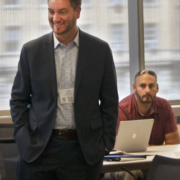Traffic Engineering Lessons Guide Teens through Crash Prevention Concepts
A standard curriculum for a science class does not include an exploration of Transportation occupations. Engineering topics are covered, but the specific roles of the people who build and maintain our transportation systems are not.
Always looking for ways to provide a broader range of learning experiences to her students, Hope Mikkelson, a science teacher at Verona Area High School in south central Wisconsin, was excited to learn of the suite of free STEM lesson plans from NanoSonic. She immediately began preparations to bring them to the Science Club she mentors.
“These students are always wanting to learn. As teachers, we develop lessons within the curriculum, but that can be very regimented. These students want more,” said Mikkelson.
Team leaders of the club, all of whom were juniors, came together to work through, “Lesson 2: Stopping Distance and Crash Avoidance Laboratory Exercise Grade 9-12,” the second lesson plan in a module on crash prevention in this suite. Students, Gail, Chris, Meg, Molly, and Celia, gave up their lunch period to explore the activities and concepts.
Gail and Meg read through the lesson plan ahead of time and provided some feedback.
“The lesson plans are easy to follow. Each was 90 to 120 minutes long. I would suggest making them 50 minutes long or creating a definite stopping point in the middle,” said Gail.
The lesson plans were developed to be used in an after-school STEM program. For groups like this one, being able to fit the lesson plans into a classroom period would be beneficial.
 Mikkelson guided the students through an initial thought exercise. She posed the question, “Why are more and more intersections being built as roundabouts rather than traditional four-way intersections, or crossroads?”
Mikkelson guided the students through an initial thought exercise. She posed the question, “Why are more and more intersections being built as roundabouts rather than traditional four-way intersections, or crossroads?”
To answer this question, the students broke into two groups. They discussed the questions and drew models of both types of intersections on the white board. Then, the groups discussed the effects of collision on a car, on the human body. After working separately, the two groups came together to discuss their findings.
Crash scenarios that the students expected to see in roundabouts included side swipes and fender benders. Gail pointed out that collisions in roundabouts will likely be between vehicles traveling in the same direction, at similar speeds, so, the impacts will probably have less force.
All of the students have their driver’s licenses. During the discussion, their personal experiences were brought into the discussion. While they may not have referred to them in these terms, students shared their experiences with human factors and driver-assist technologies. Their experiences with a student parking lot filled with inexperienced drivers illustrated some key challenges with traffic flow and congestion. And, Chris has more than one friend who has backed into something while using a backup-assist video camera. Because the camera only showed what’s directly behind the vehicle and not the sides, his friends have gotten into trouble by relying too heavily on what is displayed on the screen.
“These lessons make the ideas behind Traffic Engineering more meaningful for the students,” said Mikkelson.
This suite of Transportation-focused lesson plans created as part of a Small Business Innovative Research (SBIR) program sponsored by the U.S. Department of Transportation was highlighted by MTWC last year. At the time, NanoSonic had worked with STEM teachers in the Giles County, Virginia school district to pilot and field test the lessons and were starting to get the word out to other educators.




